译林牛津英语7bu5教案
- 格式:doc
- 大小:65.50 KB
- 文档页数:9
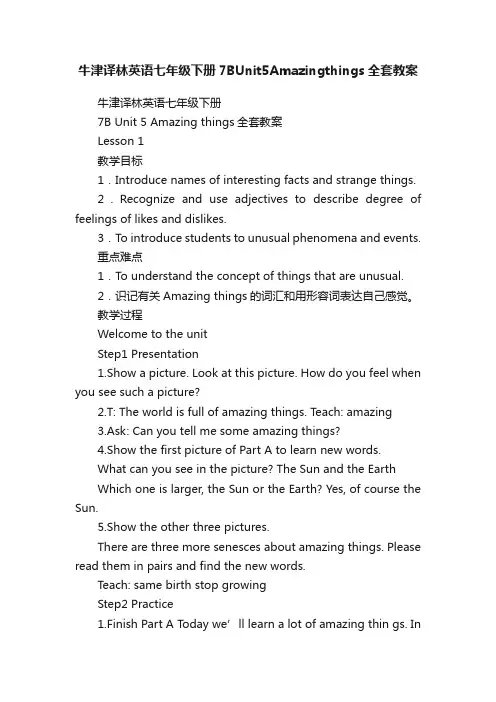
牛津译林英语七年级下册7BUnit5Amazingthings全套教案牛津译林英语七年级下册7B Unit 5 Amazing things全套教案Lesson 1教学目标1.Introduce names of interesting facts and strange things.2.Recognize and use adjectives to describe degree of feelings of likes and dislikes.3.To introduce students to unusual phenomena and events.重点难点1.To understand the concept of things that are unusual.2.识记有关Amazing things的词汇和用形容词表达自己感觉。
教学过程Welcome to the unitStep1 Presentation1.Show a picture. Look at this picture. How do you feel when you see such a picture?2.T: The world is full of amazing things. Teach: amazing3.Ask: Can you tell me some amazing things?4.Show the first picture of Part A to learn new words.What can you see in the picture? The Sun and the EarthWhich one is larger, the Sun or the Earth? Yes, of course the Sun.5.Show the other three pictures.There are three more senesces about amazing things. Please read them in pairs and find the new words.Teach: same birth stop growingStep2 Practice1.Finish Part A T oday we’ll learn a lot of amazing thin gs. InPart A, you can see four pictures. Please match the pictures with the sentences. Practice reading the sentences by yourselves.2.Let’s read the sentences again. And t ry to remember them.3.Close your books and let me see if you can remember the four amazing things.(1)sleep with their eyes open. (Fish)(2)Our nose and ears never ,but our are the same size from birth. (stop growing eyes)(3)The Sun is about 1,300,000 larger than the . (times Earth) (4)There are no in the back of elephants’ feet----only fat. (bones)Step3 Presentation1.Now you have learnt some amazing things. How do you feel?Adj. words: amazing cool funny wonderful interesting2.Kitty and Amy are talking about the fun facts in Part A. Listen to their conversation and tell me which pictures they’re talking about and what they think of the facts.3.Answer: They’re talking about Picture 1 and4. They think they’re interesting and amazing.4.Read after the tape.5.Read in roles. Read together. Try not to look at the book if you can.Step4 Show1.Show the four pictures of Part A. Make a model conversation.2.The world is full of amazing things .Please talk about them with your partners. You can use kitty and A my’s conversation a s a model.3.Can you tell us some amazing things?Comic stripStep1 Presentation1.Hobo and Eddie are talking about something strange in the sky. Do you know what they are talking about? Let’s have a look.2.Picture1: What’s in the sky? Look at Eddie and Hobo, can you guess what they’re saying?3.Picture2: What does Hobo think it is? Does he think it’s a UFO?4.Picture3; Picture45.Open books, read after the tape and check your answers at the same time.Step2 Practice1.Let’s dub this co mic, can you demonst rate with me to the whole class?2.Work in pairs. You can add your own ideas to your short play.Step3 Homework1.Try to remember the words, phrases and sentences2.Try to repeat comic strip and Part B3.Preview ReadingLesson 2教学目标1.To introduce the style of the ghost story.2.To identify specific meaning by scanning the text.3.To predict meanings of specific words from the context.4.To summarize key points of a story by Sequencing statements.5.To know the strange thing happened to Millie and Amy.重点难点1.Learn how to write the article.2.To know the main idea, and to learn the reading skill.3.To identify key events and infer general meaning.教学过程Srep1 Lead-in1.Listen to the tape. Isn’t it strange? Are you afraid? What do you think it is?Teacher say: Someone might think it’s a ghost. Actually, there’s no such things as ghost.2.Tell: There are many ghost stories in Chinese history. You must have read some, right? Do you want to read a modern ghost story?3.Today we’ll read a ghost s tory. Pay attention to the caption and the picture. Can you tell me where the store happens and who might see a ghost?Step2 Presentation1.Now there’s a story. Listen carefully and tell me what the ghost was.2.Read the article together.(1)Where did the whisper come from?(It came from bushes behind the tree)(2)Who found the ghost? (Andy)Step3 PracticeFinish PartB3 Check in pairs, then check together.Finish PartB2 in pairs.Fill in the blanks:One Sunday morning, Millie and Amy s under a big tree in Sunshine Park as u .S , they heard a w .They turned around but found nothing. They asked but nobody r .They left q .On their way home, they met Andy. He came to the park and s the bushes carefully. He found the ghost was a w cat. Later that day, theytook the cat to the animal centre.(sat, usual, Suddenly, whisper, replied, quickly, searched, weak)Step4 Show1.Andy is a brave and helpful boy.It’s the role-play time. Work in pairs. One will be Andy, and the other will be a reporter from your school newsletter.2.Questions:(1)When did Millie and Amy go to Sunshine Park? (On a Sunday morning)(2)What did they hear? (They heard a whisper)(3)Were they afraid? (Yes, they were very afraid)(4)What did they tell you? (They told me there was a ghost in the park)(5)What did you find? (I found a little cat)(6)Who made the sound? (The little cat did)(7)Why did the little cat sound like a ghost? (Because it was very weak. When it miaowed, it sounded like a whisper)(8)Where’s the little cat now? (We took it to the animal centre)(9)Were they afraid after that? (No, they weren’t)3.Ask and answer in pairs.Step5 HomeworkRead and try to repeat the whole article.Lesson 3教学目标1.To summarize key points of a story by sequencing statements.2.To identify key events and infer general meaning.3.To do the exercises correctly and read the text fluently.4.To understand the concept of things that are unusual.重点难点1.一般过去式的变化2.重点词语的用法教学过程Step1 Revision1.Read the article para by para.2.Please answer the questions as quickly as possible. Try to use the sentences from the text. (1)How many people are there in the story? Who are they? (Three. They are Millie, Amy and Andy)(2)Where did the two girls usually play in the park? (Under a big tree)(3)What did they do after they heard a strange whisper? (They turned around and asked” Is anybody there?”)(4)How did they feel? (They were very afraid)(5)Who did they meet on their way home? (They met Any)(6)How did Andy find the cat?(He went to the park, stood beside the tree and listened carefully. When he heard the whisper, he searched the bushes)(7)How did Millie and Amy feel when they learnt the ghost was a weak cat? (They were very surprised)(8)Where did they take the cat? (They took it to the animal centre)3.Try to reread the whole article.Step2 Presentation1.Solve the problems about new words in groups.2.Finish PartB1 by themselves.3.Explain the language points.Step3 Practice1.Finish PartB4 and read the dialogue in roles.2.Fill in the blanks.(1)There are some (bush) around our school playground.(bushes)(2)Our English teacher told us to listen to the radio (careful)(carefully) (3)We came to school yesterday as (usually).(usual)(4)Be quick! I said to (my).(myself)(5)The child are very happy because they are on (them) way home.(their)Step4 ShowWork in groups of four. Each group has a student as the narrator.Millie Amy Andy 旁白Step5 Homework1.Remember the phrases and sentences of this lesson.2.Finish the exercises.3.Preview Gramma.Lesson 4教学目标1.To know the form and the use of the simple past tense2.Use the simple past tense3.规则动词+ed后的读音4.不规则动词过去式的变化重点难点1.规则动词+ed后的读音2.不规则动词过去式的变化教学过程Step1 Lead-in1.Ask: How many days are there in a week? What are they?Revise there are seven days in a week2.Ask: What day is it today? What day was it yesterday?Today is… Yesterday was…3.Revise ReadingIt (be) Sunday morning. Millie and Amy (sit) under a big tree. They (hear) a whisper but (find) nothing. They (run)away quickly and(meet)Andy. He (go) to the park and found the ghost (be) a cat. They (take) the cat to the animal centre.(was, sat. heard, found, ran, met, went, was, took)Step2 Presentation1.T: Where’s the schoolbag?S: It’s in the desk.T: Where’s the schoolbag now?S: It’s on the desk.2.Write: The schoolbag is on the desk nowAsk: But where was the schoolbag a moment ago?Write: The schoolbag was in the desk a moment ago.3.Ask: What do you do every day?Write the key words: every day: get up----wash face----go to school---have lunch---do sports Yesterday: got up--- washed face---went to school—had lunch---did sports4.Talk in groups. Teacher summary:We use the Simple Past Tense to talk about things in the past.Step3 Presentation1.呈现动词和他们的过去式形式。
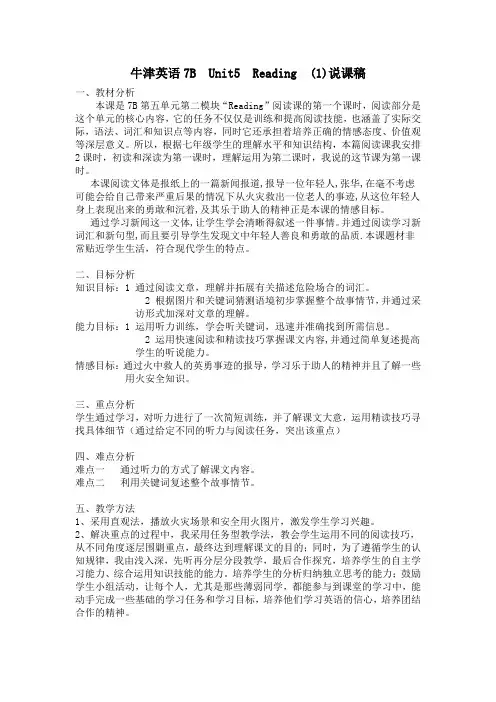
牛津英语7B Unit5 Reading (1)说课稿一、教材分析本课是7B第五单元第二模块“Reading”阅读课的第一个课时,阅读部分是这个单元的核心内容,它的任务不仅仅是训练和提高阅读技能,也涵盖了实际交际,语法、词汇和知识点等内容,同时它还承担着培养正确的情感态度、价值观等深层意义。
所以,根据七年级学生的理解水平和知识结构,本篇阅读课我安排2课时,初读和深读为第一课时,理解运用为第二课时,我说的这节课为第一课时。
本课阅读文体是报纸上的一篇新闻报道,报导一位年轻人,张华,在毫不考虑可能会给自己带来严重后果的情况下从火灾救出一位老人的事迹,从这位年轻人身上表现出来的勇敢和沉着,及其乐于助人的精神正是本课的情感目标。
通过学习新闻这一文体,让学生学会清晰得叙述一件事情。
并通过阅读学习新词汇和新句型,而且要引导学生发现文中年轻人善良和勇敢的品质.本课题材非常贴近学生生活,符合现代学生的特点。
二、目标分析知识目标:1 通过阅读文章,理解并拓展有关描述危险场合的词汇。
2 根据图片和关键词猜测语境初步掌握整个故事情节,并通过采访形式加深对文章的理解。
能力目标:1 运用听力训练,学会听关键词,迅速并准确找到所需信息。
2 运用快速阅读和精读技巧掌握课文内容,并通过简单复述提高学生的听说能力。
情感目标:通过火中救人的英勇事迹的报导,学习乐于助人的精神并且了解一些用火安全知识。
三、重点分析学生通过学习,对听力进行了一次简短训练,并了解课文大意,运用精读技巧寻找具体细节(通过给定不同的听力与阅读任务,突出该重点)四、难点分析难点一通过听力的方式了解课文内容。
难点二利用关键词复述整个故事情节。
五、教学方法1、采用直观法,播放火灾场景和安全用火图片,激发学生学习兴趣。
2、解决重点的过程中,我采用任务型教学法,教会学生运用不同的阅读技巧,从不同角度逐层围剿重点,最终达到理解课文的目的;同时,为了遵循学生的认知规律,我由浅入深,先听再分层分段教学,最后合作探究,培养学生的自主学习能力、综合运用知识技能的能力。
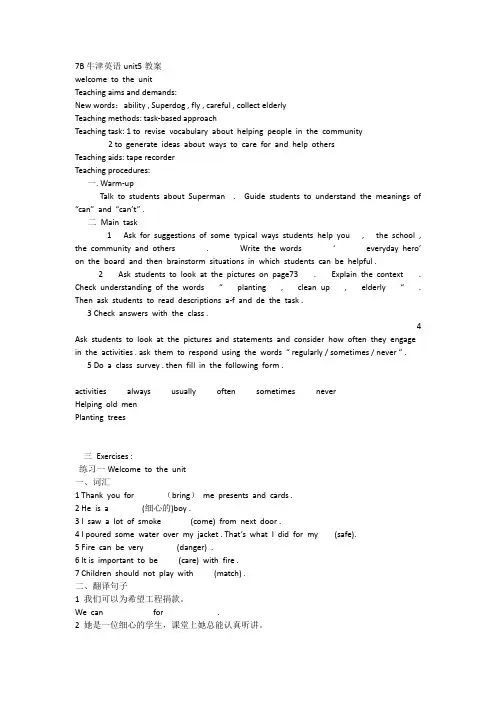
7B牛津英语unit5教案welcome to the unitTeaching aims and demands:New words:ability , Superdog , fly , careful , collect elderlyTeaching methods: task-based approachTeaching task: 1 to revise vocabulary about helping people in the community2 to generate ideas about ways to care for and help othersTeaching aids: tape recorderTeaching procedures:一. Warm-upTalk to students about Superman . Guide students to understand the meanings of “can” and “can’t” .二Main task1 Ask for suggestions of some typical ways students help you , the school , the community and others . Write the words ‘ everyday hero’ on the board and then brainstorm situations in which students can be helpful .2 Ask students to look at the pictures on page73 . Explain the context . Check understanding of the words “ planting , clean up , elderly “ . Then ask students to read descriptions a-f and de the task .3 Check answers with the class .4 Ask students to look at the pictures and statements and consider how often they engage in the activities . ask them to respond using the words “ regularly / sometimes / never “ .5 Do a class survey . then fill in the following form .activities always usually often sometimes neverHelping old menPlanting trees三Exercises :练习一Welcome to the unit一、词汇1 Thank you for (bring) me presents and cards .2 He is a (细心的)boy .3 I saw a lot of smoke (come) from next door .4 I poured some water over my jacket . That’s what I did for my (safe).5 Fire can be very (danger) .6 It is important to be (care) with fire .7 Children should not play with (match) .二、翻译句子1 我们可以为希望工程捐款。
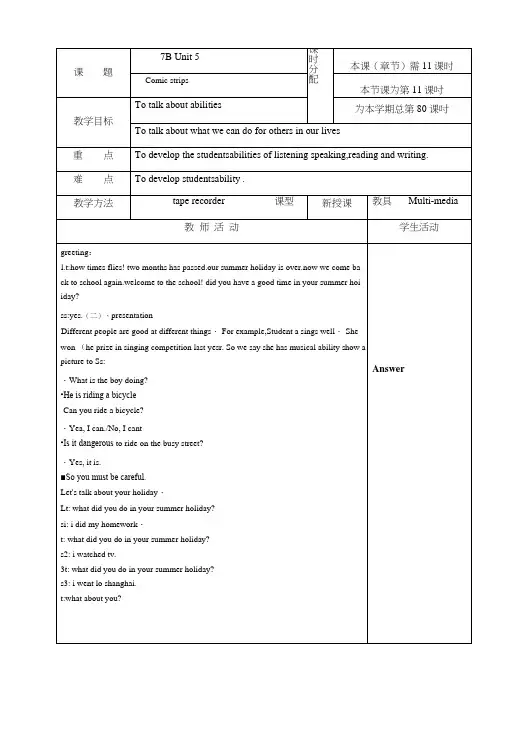
课题7B Unit 5课时分配本课(章节)需11课时Comic strips本节课为第11课吋教学目标To talk about abilities 为本学期总第80 课吋To talk about what we can do for others in our lives重点To develop the studentsabilities of listening speaking,reading and writing.难点To develop studentsability .教学方法tape recorder 课型新授课教具Multi-media教师活动学生活动greeting:l.t:how times flies! two months has passed.our summer holiday is over.now we come back to school again.welcome to the school! did you have a good time in your summer hoiiday?ss:yes.(二)、presentationDifferent people are good at different things・ For example,Student a sings well・ Shewon (he prize in singing competition last yesr. So we say she has musical ability show apicture to Ss:・What is the boy doing?•He is riding a bicycle-Can you ride a bicycle?・Yea, I can./No, I cant•Is it dangerous to ride on the busy street?・Yes, it is.■So you must be careful.Let's talk about your holiday・Lt: what did you do in your summer holiday?si: i did my homework・t: what did you do in your summer holiday?s2: i watched tv.3t: what did you do in your summer holiday?s3: i went lo shanghai.t:what about you?Answers4: i swam in the river and saw some films.t: what did you do in your summer holiday?s5: i played computer games・3上did you help others in your summer holiday?sl:yes.t: what did you do to help others?si: i helped mother cook・t:did you help others in your summer holiday?sl:yes ・s2: i helped my mother clean the house・t:did you help others in your summer holiday?sl:yes ・s3: i helped my little brother with the lessons.looking at some pictures then discuss how to help others:1.t:what can you do on the road to help others?si: i can help the old man cross the road.t:what can you do on the road to help others?s2: i can visit the home for the elderly・2.t:what can you do on the bus to help othersski can give a seat to the old man ・t:what can you do on the bus to help others?s2:i can help the old man go upstairs・t:what can you do on the bus to help others• • •extending:1.t: different people have different abilities.they can do different things to help others.i hop e everyone of you can help others when they are in trouble, please show love to others.2.ss: read a text about how to help others. Give the answersCheck out the answersWrite the words on the Bb.ReadWrite the key words作业Revise this period,finish the exercises.板书设计what can you do in the park/in the school/on the bus/on the road…? i can•••help the old man cross the roadvisit the home for the elderlygive a seat to the old manhelp the old man go upstairsgive a seat to the woman with a babyclean up the park• ■ ■教学后记课题7B Unit 5课时分配本课(章节)需11课时welcome to the unit本节课为笫11课时教学目标To talk about abilities 为本学期总第80 课时To talk about what we can do for others in our lives重点To develop the students* abilities of listening ‘speaking,reading and writing.难点To develop students^ ability ・教学方法tape recorder 课型新授课教具Multi-media教师活动学生活动greeting:l.t:how times flics! two months has passcd.our summer holiday is over.now we come back to school again.welcome to the school! did you have a good time in your summer hoiiday?ss:yes.(二)、presentation:Lt: what did you do in your summer holiday?si: i did my homework.t: what did you do in your summer holiday?s2: i watched lv.3t: what did you do in your summer holiday?s3: i went to shanghai.t:what about you?Answers4: i swam in the river and saw some films. t: what did you do in your summer holiday?s5: i played computer games.3.t:did you help others in your summer holiday?sl:yes.t: what did you do to help others?si: i helped mother cook・t:did you help others in your summer holiday?sl:ycs ・s2: i helped my mother clean the house・t:did you help others in your summer holiday?sl:yes ・s3: i helped my little brother with the lessons.(三)、looking at some pictures then discuss how to help others: 1.t:what can you do on the road to help others?si: i can help the old man cross the road.t:vvhat can you do on the road to help others?s2: i can visit the home for the elderly.2.t:what can you do on the bus to help others Give the answers Check out the answersWrite the words on the Bb.Readsl:i can give a seat to the old man ・t: whai can you do on the bus to help others?s2:i can help the old man go upstairs.t: what can you do on the bus to help others• • •extending:1.t: different people have different abilities.they can do different things to help others.i hop e everyone of you can help others when they are in trouble・ please show love to others・2.ss: read a text about how to help others.作业Revise this period,finish the exercises.板书设计what can you do in the park/in the school/on the bus/on the road---? i can …help the old man cross the roadvisit the home for the elderlygive a seat to the old manhelp the old man go upstairsgive a scat to the woman with a babyclean up the park• ■ ■教学后记课题7B Unit 5课时分配本课(章节)需11课时Reading 1本节课为第2课吋教学目标guess context from the text type the titleand the picture・为本学期总第80 课时To introduce iind expand vocabulary to describe dangerous situations-重点To infer general meaning from picture and actions.难点To identify the name of specific places and actions-教学方法tape recorder 课型新授课教具Multi-media教师活动学生活动Teaching proceduresStep 1 .RevisionRevise what the children learned in the last period・l..be careful 2.Helping Hands Club3.give seat to someone on the bus4. collect things for Project Hope5.Clean up the park/playground6.visit a home for the elderly7. plant trees 8.a SuperdogStep2 Reading1.warming up: Talk about danger and potential hazards at home・ Askif any students have ever had an accident at home・ Talk about what to doin case of dange匚2.Watch a set of pictures about a fire to present the new words:neighbor, smoke, fire, rush, dangerous, burn, hurt, pour, rush, save, blanket,put out the fire3.Read the story and try to get some information. Then say T or Faccording to the text.1 )・ Wang Fang helped her classmate out of a fire・2).Wang Fang's neighbour is 79 years old.3).Mr Sun couldn't get out because he hurt his arm.4).Wang Fang was afraid when she saw a lot of smoke.5).Wang Fang put out the fire with a blanket and helped Mr Sun out.6).The fire burned Wang Fang5s neck and leg.7).Wang Fang was in hospital for two months.8).Wang Fang said she was glad to help others and fire was notdangerous.Answer4. Listen and read after the text and ask questions.1). How old is the brave girl?2). When did she help her neighbour out of a fire?Give the answers3). How old is Mr Sun?Check out the 4). Where was Mr Sun when there was a fire?answers5). Why couldn9t Mr Sun get out of his house?6). How did Wang Fang put out the fire?7). Did Wang Fang hurt herself? Write thethe Bb.words on8). How long was Wang Fang in hospital?5. Discuss any problems about the text. Read6. Game :Write the definitions fromPartB 1 on the cards. Mix up thecards and let each group guess the word and read out theword. One who gets the most cards is thewinne 匚7. Have an interview.First fill in the blanks and read the conversation. Then have an interview ingroups・ One is Wang Fang, the others are the reporters.8. Discuss in groups. What does the writer think of Wang Fang? What doyou think about her? Why do you think so? What do you do when you meetthe accident like this?Step3Assignment1. Recite the new words and read the text.2.F inish the exercises in the workbook・3.Prepare the interview for the brave girl.作业Revise this periodjmish the exercises板书设计1) . Wang Fang helped her classmate out of a fire.2).Wang Fangs neighbour is 79 years old.3).Mr Sun couldn't get out because he hurt his arm.4).Wang Fang was afraid when she saw a lot of smoke.5).Wang Fang put out the fire with a blanket and helped Mr Sun out.6).The fire burned Wang Fang's neck and leg.7)-Wang Fang was in hospital for two months.8).Wang Fang said she was glad to help others and fire was not dangerous.教学后记课题7B Unit 5课时分配本课(章节)需11课时Reading2本节课为第3课吋教学目标1・ Further understanding the text.为本学期总第80 课时2. Learn more about fire safety.重点 3.To use different suitable adjectives to describe people's behavior and character.难点 4.1ntroduce the use of the prefix un- and suffix -less to form opposites.教学方法tape recorder 课型新授课教具Multi-media教师活动学生活动Teaching procedures:Step 1 .RevisionRevise the vocabulary in the text by giving the definitions.Ask students to read the text after the tape again・Let students ask and answer questions about the story.Revise the key words phrases and sentences •1 •help sb out of a fire help with /(to)do sth.2.alone/lonely eg:I often stay home alone on Sundays but I don9t feellonely ・3.hear sb do /doing sth; see do/ doingI often hear the girl next door play the piano in the morning.Last night when I was doing my homework, suddenly I heard someoneshouting "help! Help!".4 a 79-year-old Mr Sun an 8-day holiday two-hour homework5.hurt The boy fell off the bicycle and hurt his leg. hurt by fireAnswer学生活动6.p our... Over7.put out the fire put on/ up/down/ into/away8.be in hospital/be in the hospital Grandpa is ill badly today. Now he is hospital. His fater works in the hospital.9.It is important to be careful with fire. Be care with sth Children must be careful with matches.lO.keep one's life from danger keep ... from I should keep my father from smoking・11 .Thank you for joining us this evening.Step 2 Visit Wang Fang in hospitalFirst read the task to understand it.Read the dialogue to find out and correct the mistakes.Read the conversation in pairs.Act it out.Step3 An interviewDo it in groups. In each group one student can be Wang Fang, the others can be reporters to interview her. Then choose some groups to perform . Step4.Fire safetyRead the sentences and match the right pictures・Read out the sentences・Notes: leave ...on , keep away fromAsk students to think of other ways about fire safety. Eg: Don't run on the stairs. Don't play on the road. Don't lean out the window.Step5.Assignment: Give the answersCheck out the answersWrite the words on the Bb.Read教师活动学生活动1 •Revise what we learned from P74-76 and remember the new words.2. Do some exercises.The Fourth Period作业Revise this periodjmish the exercises板书设计help sb out of a fire help with /(to)do sth. alone/lonely eg:I often stay home alone on Sundays but I don?t feel lonely・ hear sb do /doing sth; see do/ doing1 often hear the girl next door play the piano in the morning.Last night when I was doing my homework, suddenly I heard someone shouting "help! Help!: a 79-year-old Mr Sun an 8-day holiday two-hour homework hurt The boy fell off the bicycle and hurt his leg. hurt by fire pour... overIt is important to be careful with fire. Be care with sth Children must be careful with matches. keep one's life from danger keep ・..from I should keep my father from smoking・教学后记课题7B Unit 5课时分配本课(章节)需11课时Grammar 1本节课为第4课时教学目标Using "can'7 “could" to talk about ability为本学期总第80 课时重点Using "can'7 "could" to talk about ability难点教学方法tape recorder 课型新授课教具Multi-media教师活动学生活动1. Revise the use of Model Verbs and learn about positive,negative and question sentences.2. Make a list of things that the students can do by themselvesnow.(At least ten kinds)IILTeaching Aims:To recognize and understand how to use 44can,?and “coulcT to expressability in the present and past.IV.Important and Difficult Points:"Could" is used to express ability in the past.V.Teaching Procedures:Step 1 • Warming up.1) Make a survey.“What can you do now?"Ask:Can you ride a bike / swim / fly a kite / play football / play chess? Yes ,I can. / No, I cantShow the students' answers on the screen .SportsStudent AStudent BRide a bikeSwimFly a kitePlay footballPlay chessAnswerThen ask the others:Can she/ he ...?2)Say the whole sentences: eg: A. can ride a bike.He can% / cannot swim..・・(Write them down on the blackboard.)Get the students to repeat and talk about student B like above:3)Work in pairsAsk the partner more questions like above and write down their answers , then report to the class・Step 2. Presentation.1)Ask student A and B again:Could you ride a bike five years ago ?(Help them answer:Yes, I could./ No, I couldnt)2)Get the students to ask the teacher about the past of A and B. Could he / she …? (Yes, he / she could. / No, he / she couldn't.)3)Teach the students to say the whole sentences:A could ride a bike five years ago.He couldn^t swim five years ago.(The same as B)4)Use “coulcT to ask the partner the same questions about the past, then repeat・5)Work out the rule.①Positive: cancould②Negative: can' tCouldn't③Question: Can …?Could -?Step 3. Practice.1)Work alone.(Part A1)2)Get the students to report themselves like above・3)Talk about the tables freely. in pairs・eg. Can Sandy row a boat now?Could he do it last year?4)Complete the conversation of Part A2.5)Explain:We can use <4am (is , are) able to 44instead of “canjand “was (were) able to 44Give the answersCheck out the answersWrite the words on the Bb.Readeg•①Mike can sing more than 20 English songs.Mike is able to ...②She could speak English when she was foui\She was able to...Get the students to give more examples.Sum up:1)The differences between “caiT and “be able to^2)Another use of “can'' & “could":Eg.Can / Could I help you?Step 4. Consolidation:Work in groups of six.Make a survey, then report to the class・ Things to doCould do before, (numberof students)Can do now・(number of students). Tell stories. Write Englishwords・ Do housework・ Plant trees.Feed animals. Make dinners作业Revise this period,finish the exercises板书设计Could you ride a bike five years ago ?(Help them answer:Yes, I could./ No, I couldn't.)Could he / she ...? (Yes, he / she could. / No, he / she couldn't.) A could ride a bike five years ago. He couldn't swim five years ago.教学后记课题7B Unit 5课时分配本课(章节)需11课时Grammar 2本节课为第5课吋教学目标Using "can'7 "coukT to talk about ability为本学期总第80 课时Expressions with n what H and M how H重点Using "can'7 "coukT to talk about ability难点Expressions with M what n and M how H教学方法tape recorder 课型新授课教具Multi-media教师活动学生活动V-Teaching Procedures:Step 1 • Guessing a riddle.It can live in wate匚It can breathe under wate匚It can swim・ It can livein a glass bowl. People can feed and watch them every day. What is it?(A goldfish)Step 2. Revision.Make different kinds of sentences with “carT and “could:1 )read English story books.(last year)2)m end computers.(two years ago)3)help Mother do housework.(at the age of seven) Step 3. Presentation.1 .Say:①Zhang Hua works hard .It is possible for him to pass the exam.(He can pass the exam)②Nick didn,t bring a football to school.It is not possible for us to play football after class・(We can't play football after class.)③It was sunny last Sunday・ It was possible for the children to go to thepark.(The children could go to the park)©Millie had no money yesterday. It was not possible for her to buy that coat.(She could n't buy that coat.)2.Show the sentences above on the screen and explain them to the students:We use “can” / “coukT to say that something is / was possible to happen.3. Get the students to explain with "possible".Answer①Fire can be dangerous if we are not careful.②JVk・ Sun can,t be at home because I saw him at school just now.③I didn' t lose my key so I could get in.④Mr. Sun could not get out because he hurt his leg.Step 4. Practice: Give the answers1 •Fill in the blanks・2. Work in pairs to talk about something that can / could / can't /couldn^t happen. Check out the3. Report to the class. answers4. Explain:If we think something is sure to happen, We'd belter use "musT.eg.I saw Mr Yang in the library a moment ago. He must(一定)be in theschool now.(Get the students to give more examples)Step 5. Presentation.1 •Ask: Write the words on May I speak to ...? the Bb.May I take this picture away?2.Introduce the idea that we also use “may" and "might" to expresspossibilities.Readeg.I am free today, I may go on an outing.He feels very tired, He might have a good rest at home・3. Explain the tables at the top of the page.Note:l)"Might” is the past from of “may", but here it is also used to expressdegrees of possibilities.2)The differences between “my/mighL and "can/coulcT.Step 6.Practice・1. Fill in the blanks alone, and try to underline the keywords that theanswers comefrom, then check the answer.2.Explain: maybe / may be3.Read the table and complete the sentences.The members of the Helping Hands club want to look after Mi; Sun inhospital Please infer the possibilities according to the tables and fill in theblanks with “may (not)” or “might (not)^.NameDays and TimeNear PlansDanielMonday( 16:00—18:00)Go to the Reading Club( 15:30—18:00)SandyTuesday( 16:30一18:00)Go to the Music Club( 14:00—15:30)SimonWednesday( 15:45—18:00)Have a football match( 13:00—15:40)KittyThursday(16:15—18:00)Go to the Dancing Club(l8:00—20:00)AmyFriday( 15:30—17:40)Have Swimming Lessons( 17:30一21:00)MillieSunday(8:00—ll:00)Have nothing to do this day.1.Daniel go and see Mr Sun on Monday.2.Sandy go to see Mr Sun on Tuesday.3.Simon go to the hospital to help Mr Sun on Wednesday.4.K itty go to help Mr Sun on Thursday.5.A my help Mr Sun on Friday・6.M illie go to help Mr Sun on Sunday.(Key: l.may not 2.may 3.might 4.might 5.might not 6.may) Step 7.Extensioru You are trapped into a lonely island・ How can you escape ? Please think of more ways. You'd better make sentences with “may,’ or “might:Step 8. HomeworkEx B on the workbook.作业Revise this periodjmish the exercises板书设计1 ・Daniel go and see Mr Sun on Monday.2.Sandy go to see Mr Sun on Tuesday.3.Simon go to the hospital to help Mr Sun on Wednesday.4.K itty go to help Mr Sun on Thursday.5.A my help Mr Sun on Friday.6.M illie go to help Mr Sun on Sunday.(Key: 1 .may not 2.may 3.might 4.might 5.might not 6.may)教学后记课题7B Unit 5课时分配本课(章节)需11课时Integrated skills本节课为第6课吋教学目标Learn to write a profile.为本学期总第80 课时Leam to talk about what you can and cannot do.重点To develop the students' abilities of listening speaking,reading and writing.难点Learn to write a profile.教学方法tape recorder 课型新授课教具Multi-media教师活动学生活动Teaching procedures:Step 1: Warming upPlay a game: Who is he\she ?Eg: She has a round face and two big eyes・ She has long hair in a ponytail・Who is she ?Step 2:Daily report: A profile of myself ・Ask and answer about it.Step 3: Pre- task preparation1 •Ask some very general questions about reports and school .2.Present some new words : term,memory,history,geography,personality,anize,result.Step 4: Task proceduresAnswer教师活动学生活动Part A:1 •Reading(1) Ask students to skim the text to identify any words they don,t Give the answers know •(2) Ask students to guess the meaning of the unknown words from the Check out theanswerscontext.(3) Explain the meaning by giving examples .(4) Ask students to list as many adjectives as they can find ・ Then askthem to add other adjectives that teachers may use to describe students .Write the words on (5) Ask students to study the notes for the parentsmeeting . Then ask the Bb.them to find information from the report card to fill in as many gaps aspossible ・Read2 • Listening(1) Play the recorder and ask students to complete Mr WiTs notes .(2) Play the recorder again to enable students to check their answers .(3) Ask some students to read out their answers .3 . WritingA: Complete the profile of Suzy :(1) Ask students to use information from the report card and notes tocompleteSuzy's profile.(2) Ask them to guess the meaning of the new words :grade,resulthigh ・(3) Read it and work out the way of writing a profile .(Group work )B: Write a profile :教师活动学生活动(1)Divide the class into groups . Ask them to write a profile •(2)Invite some groups to show their results •3. Speaking ( Part B )(1)Listen and answerCan Millie dance ? What about Sandy ?What can Sandy do ?(2)Listen and read(3)Read in pairs(4)Make similar dialogues and act out their own dialogues ・Step 5 : Assignmentl.Onil work : Make a dialogue about talking about what you can and cannot do・2.Written work : Write a profile of your friend ・作业Revise this periodfinish the exercises.Write a profile of your friend ・板书设计(1)Listen and answerCan Millie dance ? What about Sandy ?What can Sandy do ?(2)Listen and read(3)Read in pairs(4)Make similar dialogues and act out their own dialogues ・教学后记课题7B Unit 5课时分配本课(章节)需11课时Study skills本节课为第7课时教学目标To develop students5 ability to workindependently of the teacher为本学期总第80 课时To assess students^ recog nition of model verbs and adjectives .重点To develop the students' abilities of listening .speaking,reading and writing.难点To develop students' ability to work in dependently of the teacher教学方法tape recorder 课型新授课教具Multi-media教师活动学生活动Teaching procedures :Step 1 : Warming upCrossword puzzle competition (Part B)Step 2 : Free talkPractise with the adjectives in Part B .eg : How is your best friend ?He is very helpful. He often helps me with my English ・Step 3 : Pre-task1 •Review the use of the model verbs .2. Present some new words : drama,likely,be able toAnswerStep 4 : While-taskLTell students to look at the table and read all the plans .2.Ask students to read what Daniel is thinking about and select the best model verb .Step 5 : Post-task1 ・Ask four students to read out one sentence each .Step 6 : Practice (Group work )1.Ask students to make dialogues with the model verbs .2.Ask some groups to act out their dialogues .Step 7 : Learn how to make a learning record .1.Have a discussion about what students learned in this unit.Eg: What did you study ? How to improve it ? Can you do it now ?etc.2.Explain the context of this section and the need to keep learning records •3.Ask students to look at the headings in the sample record in PartA . Elicit comments from students about the sample record .4.Ask students to use the chart to make their own learning record •Give the answersCheck out the answersWrite the words on the Bb.Read5.Encourage students to make comments about how they feel or felt about thedifferent tasks .Step 8 : Assignment1 .Make a dialogue with the model verbs •2.Make a learning record ・作业Revise this period9finish the exercises.板书设计How is your best friend ?He is very helpful. He often helps me with my English • What did you study ? How to improve it ? Can you do it now ?etc.• • •• • •教学后记课题7B Unit 5课时分配本课(章节)需11课时Main task本节课为第8课时教学目标Learn to write a recommendation letter为本学期总第80 课时To develop students^ ability of writing .重点To develop the students' abilities of listening .speaking,reading and writing.难点To develop students^ ability of writing .教学方法tape recorder 课型新授课教具Multi-media教师活动学生活动Teaching procedures :Step 1: Warming upA chain talk .eg: A: Can you tell me what you can do and cannot do ?B: I can sing but I cant sing well. Can you tell me what youcan do and cannot do ?C: I can dance well but I can't swim .........Step 2 : Free talkeg : Who can get the Most Helpful Student Award ? Why ?Step 3 : Pre-task preparationPresent some new words : chairperson,thoughtful,lose,Answerhear fromStep 4 : Task procedures:1 .Learn how to write a recommendation letter(1) Listen and answer (Part 1)Q: What award would he like to recommend Chen Dan ?What is Chen Dan good at ?What\ his personality ?What did he do ?(2 )Explain the words above.(3)Read it carefully and put the numbers in the correct boxes .(4)Read it again and find out the key aspects of the content of theletter .(Group work)(5)Conclusion about how to write a recommendation letter.2. Write a recommendation letter (Group work )(1)Ask students to plan the things they want to say about their chosen person asoutlined in Part Bl.(2)Complete the letter ・(Each writes one paragraph.) Give the answersCheck out the answersWrite the words on the Bb.Read(3) Invite some groups to read out their letters .Step 5 : AssignmentWrite a recommendation letter作业Revise this period9finish the exercises.板书设计A: Can you tell me what you can do and cannot do ?B: I can sing but I can't sing well. Can you tell me what you can do and cannot do ?C: I can dance well but I can't swim ........What award would he like to recommend Chen Dan ?What is Chen Dan good at ?What's his personality ?What did he do ?教学后记课题7B Unit 5课时分配本课(章节)需11课时revision本节课为第10课时教学目标To review what learnt.为本学期总第80 课时To develop students^ ability of writing .重点To develop the students' abilities of listening .speaking,reading and writing.难点To develop students' ability .教学方法tape recorder 课型新授课教具Multi-media教师活动学生活动句型转换:1 ・Our team can win the game if we play well.否定句一般疑问句2.Lucy and Lily may go to Beijing for their holiday.否定句一般疑问句3.The boy might catch the last bus.否定句一般疑问句4.She can dance.(when she was five 改写)5.They can speak Japanese well.(画线提问)st year, Mike could row a roat.(画线提问)7.Could you row a boat last month?(肯定回答)9O8.We couldn" t have a picnic last Sunday. Because it was rainy(同义句转换)It was rainy last Sunday・ It for us a prcnic・AnswerIV.改错:1 •He can't get out beause he hurt his leg・2.If he has time, he will can come.3.His father maybe a doctor.4.She can swim when she was five years old.5.Tomorrow will be sunny・ We must go to the park and fly kites.6.Simon must not play football because he forgot to bring his football shoes.7.The headmaster went out to have a meeting.He mustn^t be in the office now.8.Amy is very tall. She maybe jump high.V.汉译英:1.很可能我父母亲下周六去上海。
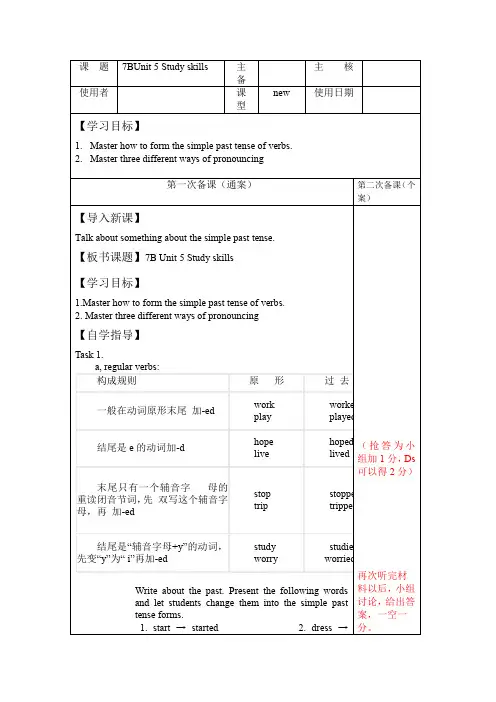
课题7BUnit 5 Study skills 主备主核使用者课型new 使用日期【学习目标】1.Master how to form the simple past tense of verbs.2.Master three different ways of pronouncing第一次备课(通案)第二次备课(个案)【导入新课】Talk about something about the simple past tense.【板书课题】7B Unit 5 Study skills【学习目标】1.Master how to form the simple past tense of verbs.2. Master three different ways of pronouncing【自学指导】Task 1.a, regular verbs:构成规则原形过去式一般在动词原形末尾加-ed workplayworkedplayed结尾是e的动词加-d hopelivehopedlived末尾只有一个辅音字母的重读闭音节词,先双写这个辅音字母,再加-ed stoptripstoppedtripped结尾是“辅音字母+y”的动词,先变“y”为“ i”再加-ed studyworrystudiedworriedWrite about the past. Present the following words and let students change them into the simple past tense forms.1. start → started2. dress → (抢答为小组加1分,Ds 可以得2分)再次听完材料以后,小组讨论,给出答案,一空一分。
dressed3. play → played4. help → helped5. use → used6. like → liked7. look → looked 8. study → studied9. plan → planned 10. cry → criedThen ask students to fill in the blanks with the pasttense forms of these words. Ask several students toshare their answers.b, irregular verbs:We form the simple past tense of irregular verbs differently. We do not add ‘ –ed’No changeChange the vowelChange the consonantChange the vowels and the consonants cost-cost, put-put come-came, ring- rang make-made, send-sent do-did, buy-boughtThen give students some words and change them into the past forms. If they don’t know , they ca n check the wordlist on Page 121.1. look looked2. live lived3. stop stopped4.carry carried5. hope hoped6. trip tripped7. call called 8. finish finished 9. want wanted10.are were 11.go w ent 12.have had13.do did 14.get got e came16.say said 17.see saw 18.put put19.eat ate 20.take took 21.read read Ask several students to write down the answers. Then check the answers in a whole.Tell them they must use the simple past tense form ofthe verbs. If they don’t know the past tense formsof these words, they can check the wordlist onPage 106-107.Task 2.Saying ‘-ed’ endingsMost verbs in the simple past tense form have ‘-ed’ endings . However, we pronounce these endings differently: /t/, /d/ or /id/ . 1.How do you pronounce the following ending ? Listen carefully and repeat these words .2.How do you pronounce the ending of these words ? Listen carefully and write / t / , / d / or / id / in the blanks in Part B.动词+ed的发音1.动词原形以清辅音结尾,ed读作/t/2.动词原形以浊辅音或元音结尾,ed读作/d/ 学生活动指导:三分钟的准备时间,答对一个可为小组加1分小组活动指导:讨论语言点。
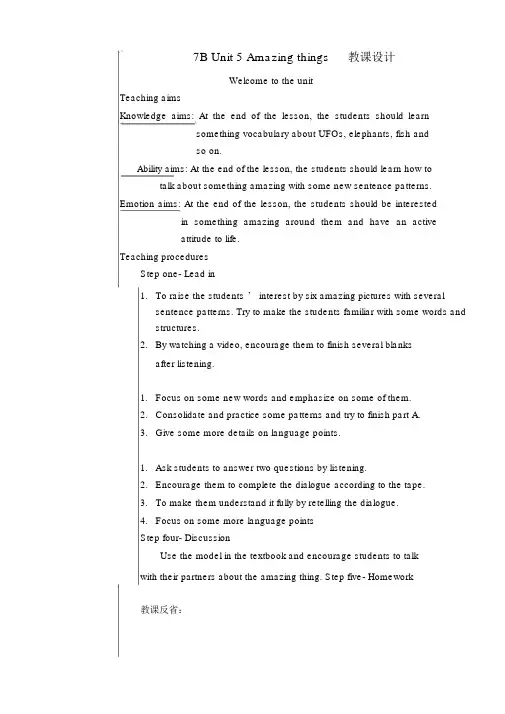
7B Unit 5 Amazing things教课设计Welcome to the unitTeaching aimsKnowledge aims: At the end of the lesson, the students should learnsomething vocabulary about UFOs, elephants, fish andso on.Ability aims: At the end of the lesson, the students should learn how to talk about something amazing with some new sentence patterns. Emotion aims: At the end of the lesson, the students should be interestedin something amazing around them and have an activeattitude to life.Teaching proceduresStep one- Lead in1.To raise the students ’ interest by six amazing pictures with severalsentence patterns. Try to make the students familiar with some words andstructures.2.By watching a video, encourage them to finish several blanksafter listening.1.Focus on some new words and emphasize on some of them.2.Consolidate and practice some patterns and try to finish part A.3.Give some more details on language points.1.Ask students to answer two questions by listening.2.Encourage them to complete the dialogue according to the tape.3.To make them understand it fully by retelling the dialogue.4.Focus on some more language pointsStep four- DiscussionUse the model in the textbook and encourage students to talk with their partners about the amazing thing. Step five- Homework教课反省:ReadingTeaching aimsKnowledge aims:To predict meaning of specific words from context.To practice the main language points of the context. Ability aims:To identify specific meaning by scanning the text.To summarize key points of a story by sequencing statements.To identify key events and infer general meaning.Emotion aims: To let the students know there are no ghosts in the world. Teaching proceduresStep one- Lead in1.To revise yesterday ’dialogues by talking about the amazing pictures with several sentence patterns. Try to make the students familiar with some words and structures.2.Revise some words by asking the students choose the correct meanings of some words.Step two- PresentationListen to the tape and ask the students to answer the following questions1.Did Millie and Amy go to Sunshine Park one Sunday morning?2.Did they hear a song from the bushes behind the tree?3.Who did they meet on their way?4.What did Andy find in the bushes?Step three-outlineFill in the blanks with the information learnedWhenWhereWhoWhatHowStep Four --detailsRead the text carefully and answer some questions on details.1. Why were Millie and Amy frightened?They heard a whisper from the bushes behind the tree.2. Who did they meet on their way home?They met Andy.3. Where did Andy find the“ ghost” ?In the bushes.How did he find it?He searched the bushes and found it.4.Why did the cat sound like a ghost?Because it was very weak.5.Where did they take the cat?6.Do you think there are ghosts in the real life?Step Five –put them in a correct orderMillie wrote some sentences about what happened, but they were not in the correct order. Help her put the sentences into the correct order. Write the numbers 1-7 in the boxes.Step Six—True or falseMillie is telling her friend Wendy on the phone about what happened in the park, but Wendy can’heart her clearly. Write a T if a sentence is true or F if it is false.Step Seven— act outFinish the dialogue between Henry and AndyStep Eight --explain some important languagepoints 1) They turned around but saw nothing.turn around 意“回,转身”。
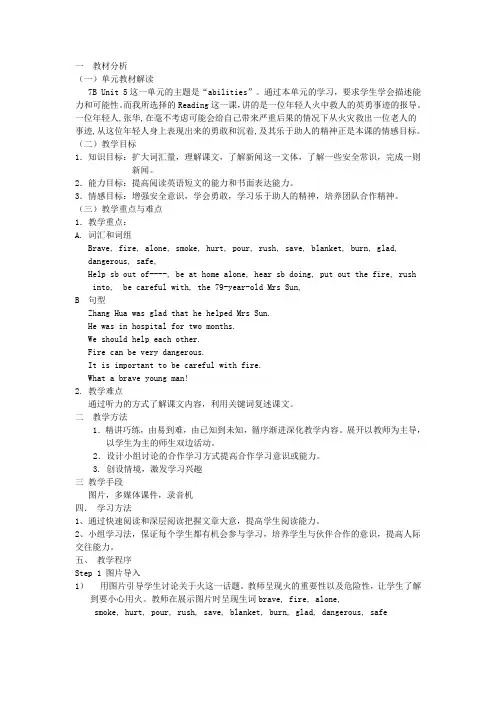
一教材分析(一)单元教材解读7B Unit 5这一单元的主题是“abilities”。
通过本单元的学习,要求学生学会描述能力和可能性。
而我所选择的Reading这一课,讲的是一位年轻人火中救人的英勇事迹的报导。
一位年轻人,张华,在毫不考虑可能会给自己带来严重后果的情况下从火灾救出一位老人的事迹,从这位年轻人身上表现出来的勇敢和沉着,及其乐于助人的精神正是本课的情感目标。
(二)教学目标1.知识目标:扩大词汇量,理解课文,了解新闻这一文体,了解一些安全常识,完成一则新闻。
2.能力目标:提高阅读英语短文的能力和书面表达能力。
3.情感目标:增强安全意识,学会勇敢,学习乐于助人的精神,培养团队合作精神。
(三)教学重点与难点1.教学重点:A. 词汇和词组Brave, fire, alone, smoke, hurt, pour, rush, save, blanket, burn, glad, dangerous, safe,Help sb out of----, be at home alone, hear sb doing, put out the fire, rush into, be careful with, the 79-year-old Mrs Sun,B 句型Zhang Hua was glad that he helped Mrs Sun.He was in hospital for two months.We should help each other.Fire can be very dangerous.It is important to be careful with fire.What a brave young man!2. 教学难点通过听力的方式了解课文内容,利用关键词复述课文。
二教学方法1.精讲巧练,由易到难,由已知到未知,循序渐进深化教学内容。
展开以教师为主导,以学生为主的师生双边活动。
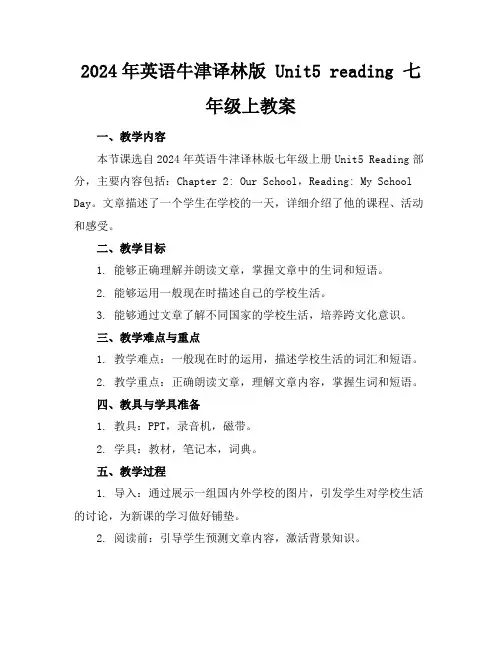
2024年英语牛津译林版 Unit5 reading 七年级上教案一、教学内容本节课选自2024年英语牛津译林版七年级上册Unit5 Reading部分,主要内容包括:Chapter 2: Our School,Reading: My School Day。
文章描述了一个学生在学校的一天,详细介绍了他的课程、活动和感受。
二、教学目标1. 能够正确理解并朗读文章,掌握文章中的生词和短语。
2. 能够运用一般现在时描述自己的学校生活。
3. 能够通过文章了解不同国家的学校生活,培养跨文化意识。
三、教学难点与重点1. 教学难点:一般现在时的运用,描述学校生活的词汇和短语。
2. 教学重点:正确朗读文章,理解文章内容,掌握生词和短语。
四、教具与学具准备1. 教具:PPT,录音机,磁带。
2. 学具:教材,笔记本,词典。
五、教学过程1. 导入:通过展示一组国内外学校的图片,引发学生对学校生活的讨论,为新课的学习做好铺垫。
2. 阅读前:引导学生预测文章内容,激活背景知识。
3. 阅读中:学生自主阅读文章,完成相应的练习。
教师进行讲解,帮助学生理解文章,学习生词和短语。
4. 阅读后:小组活动,学生运用一般现在时描述自己的学校生活。
5. 例题讲解:讲解一般现在时的用法,并给出例句。
6. 随堂练习:学生完成课本上的练习题,巩固所学知识。
六、板书设计1. 文章My School Day2. 生词和短语:course, activity, exciting, boring, interesting, at 8:00, fromto3. 一般现在时:主语 + 动词原形(三单形式)/ 现在分词七、作业设计1. 作业题目:描述你的学校生活,至少包括三个课程和三个活动。
2. 答案示例:My school day is very busy. I have three courses: Chinese, math and English. My favorite activity is playing basketball after school.八、课后反思及拓展延伸1. 课后反思:关注学生在课堂上的表现,了解他们对文章的理解程度,调整教学方法,提高教学效果。

毛庄中学2016—2017学年度第二学期七年级英语学科教学设计授课时间年月日第周星期授课班级第课时课型共案主备人马伟课题Unit 5 Comic strip & Welcome to die unit教学目标:l.To grasp the new words and phrases on P56-57; 2・To know more al)ont amazing things •3.To express the feelings of surprise教学重点To know more about amazing things .教学难点To know more about amazing things .Task-based teaching教具Tape recorder, Computer, Pictures 多媒体A:What,s amazing in the picture?A:Isn,t tliat amazing?Activity 2Step 1 :r fiy to learn the new words.Step 2: Match the pictures with the sentences.Stej) 3:Language points1.“wkh+名词+形容词/介词短语”在句中作状语.1)我们不能关着窗户睡觉。
2)李老师手里拿着一本进教室。
2.stop doing表示停止正在做的事情(只涉及到一个事件),stop to (Io则表示停止正在做的事情再去做另外一件事情(涉及到两个事件)。
1)下课了。
让我们停下来去吃午饭吧。
2)别哭了,我给你讲个笑话吧。
Activity 3Step l:Talk about the amazing things.Kitty: Do you know any fun facts about the world, Amy?Amy: Yes. The sun is about 1,300,00() times laiger than the教法基本环节及时间共案(集体备课)用案人自我创新(必须手写)过程反思SteplLead-inShow some pictures and ask some questions.Step2presentationStep3Learn theconversationActivity 1 Lead-inLook at llic pictures and answer tlic (jucstions备课组长签字: 毛庄中学2016—2017学年度第二学期七年级英语学科教学设计备课组长签字:毛庄中学2016—2017学年度第二学期七年级英语学科教学设计备课组长签字:毛庄中学2016—2017学年度第二学期七年级英语学科教学设计备课组长签字:毛庄中学2016—2017学年度第二学期七年级英语学科教学设计To use the simple past tense to talk about a past habit or state- 教学难点To use the simple past tense to talk about a past habit or state- 教学重点基本环节及时间共案(集体备课)用案人自我创新(必须手写)过程反思Stepl Preview Activity 1 New words and expressionStep 1:Sentences from this unit:Step 1: 一般过去时的定义一般过去时态用来谈论在过去发生的动作或存在的状态。
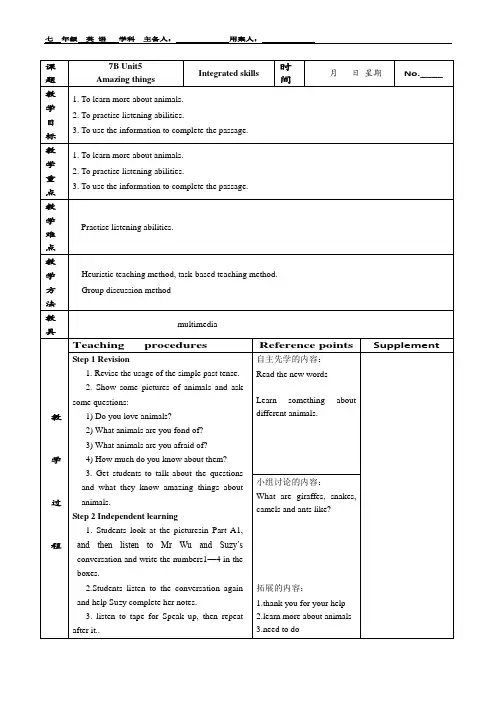
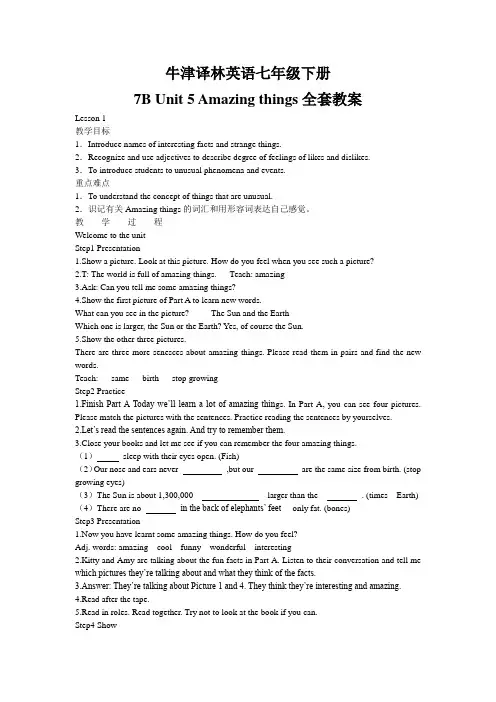
牛津译林英语七年级下册7B Unit 5 Amazing things全套教案Lesson 1教学目标1.Introduce names of interesting facts and strange things.2.Recognize and use adjectives to describe degree of feelings of likes and dislikes.3.To introduce students to unusual phenomena and events.重点难点1.To understand the concept of things that are unusual.2.识记有关Amazing things的词汇和用形容词表达自己感觉。
教学过程Welcome to the unitStep1 Presentation1.Show a picture. Look at this picture. How do you feel when you see such a picture?2.T: The world is full of amazing things. Teach: amazing3.Ask: Can you tell me some amazing things?4.Show the first picture of Part A to learn new words.What can you see in the picture? The Sun and the EarthWhich one is larger, the Sun or the Earth? Yes, of course the Sun.5.Show the other three pictures.There are three more senesces about amazing things. Please read them in pairs and find the new words.Teach: same birth stop growingStep2 Practice1.Finish Part A Today we’ll learn a lot of amazing thin gs. In Part A, you can see four pictures. Please match the pictures with the sentences. Practice reading the sentences by yourselves.2.Let’s read the sentences again. And try to remember them.3.Close your books and let me see if you can remember the four amazing things.(1)sleep with their eyes open. (Fish)(2)Our nose and ears never ,but our are the same size from birth. (stop growing eyes)(3)The Sun is about 1,300,000 larger than the . (times Earth) (4)There are no in the back of elephants’ feet----only fat. (bones)Step3 Presentation1.Now you have learnt some amazing things. How do you feel?Adj. words: amazing cool funny wonderful interesting2.Kitty and Amy are talking about the fun facts in Part A. Listen to their conversation and tell me which pictures they’re talking about and what they think of the facts.3.Answer: They’re talking about Picture 1 and4. They think they’re interesting and amazing.4.Read after the tape.5.Read in roles. Read together. Try not to look at the book if you can.Step4 Show1.Show the four pictures of Part A. Make a model conversation.2.The world is full of amazing things .Please talk about them with your partners. You can use kitty and Amy’s conversation a s a model.3.Can you tell us some amazing things?Comic stripStep1 Presentation1.Hobo and Eddie are talking about something strange in the sky. Do you know what they are talking about? Let’s have a look.2.Picture1: What’s in the sky? Look at Eddie and Hobo, can you guess what they’re saying?3.Picture2: What does Hobo think it is? Does he think it’s a UFO?4.Picture3; Picture45.Open books, read after the tape and check your answers at the same time.Step2 Practice1.Let’s dub this comic, can you demonst rate with me to the whole class?2.Work in pairs. You can add your own ideas to your short play.Step3 Homework1.Try to remember the words, phrases and sentences2.Try to repeat comic strip and Part B3.Preview ReadingLesson 2教学目标1.To introduce the style of the ghost story.2.To identify specific meaning by scanning the text.3.To predict meanings of specific words from the context.4.To summarize key points of a story by Sequencing statements.5.To know the strange thing happened to Millie and Amy.重点难点1.Learn how to write the article.2.To know the main idea, and to learn the reading skill.3.To identify key events and infer general meaning.教学过程Srep1 Lead-in1.Listen to the tape. Isn’t it strange? Are you afraid? What do you think it is?Teacher say: Someone might think it’s a ghost. Actually, there’s no such things as ghost.2.Tell: There are many ghost stories in Chinese history. You must have read some, right? Do you want to read a modern ghost story?3.Today we’ll read a ghost s tory. Pay attention to the caption and the picture. Can you tell me where the store happens and who might see a ghost?Step2 Presentation1.Now there’s a story. Listen carefully and tell me what the ghost was.2.Read the article together.(1)Where did the whisper come from?(It came from bushes behind the tree)(2)Who found the ghost? (Andy)Step3 PracticeFinish PartB3 Check in pairs, then check together.Finish PartB2 in pairs.Fill in the blanks:One Sunday morning, Millie and Amy s under a big tree in Sunshine Park as u .S , they heard a w .They turned around but found nothing. They asked but nobody r .They left q .On their way home, they met Andy. He came to the park and s the bushes carefully. He found the ghost was a w cat. Later that day, they took the cat to the animal centre.(sat, usual, Suddenly, whisper, replied, quickly, searched, weak)Step4 Show1.Andy is a brave and helpful boy.It’s the role-play time. Work in pairs. One will be Andy, and the other will be a reporter from your school newsletter.2.Questions:(1)When did Millie and Amy go to Sunshine Park? (On a Sunday morning)(2)What did they hear? (They heard a whisper)(3)Were they afraid? (Yes, they were very afraid)(4)What did they tell you? (They told me there was a ghost in the park)(5)What did you find? (I found a little cat)(6)Who made the sound? (The little cat did)(7)Why did the little cat sound like a ghost? (Because it was very weak. When it miaowed, it sounded like a whisper)(8)Where’s the little cat now? (We took it to the animal centre)(9)Were they afraid after that? (No, they weren’t)3.Ask and answer in pairs.Step5 HomeworkRead and try to repeat the whole article.Lesson 3教学目标1.To summarize key points of a story by sequencing statements.2.To identify key events and infer general meaning.3.To do the exercises correctly and read the text fluently.4.To understand the concept of things that are unusual.重点难点1.一般过去式的变化2.重点词语的用法教学过程Step1 Revision1.Read the article para by para.2.Please answer the questions as quickly as possible. Try to use the sentences from the text. (1)How many people are there in the story? Who are they? (Three. They are Millie, Amy and Andy)(2)Where did the two girls usually play in the park? (Under a big tree)(3)What did they do after they heard a strange whisper? (They turned around and asked” Is anybody there?”)(4)How did they feel? (They were very afraid)(5)Who did they meet on their way home? (They met Any)(6)How did Andy find the cat?(He went to the park, stood beside the tree and listened carefully. When he heard the whisper, he searched the bushes)(7)How did Millie and Amy feel when they learnt the ghost was a weak cat? (They were very surprised)(8)Where did they take the cat? (They took it to the animal centre)3.Try to reread the whole article.Step2 Presentation1.Solve the problems about new words in groups.2.Finish PartB1 by themselves.3.Explain the language points.Step3 Practice1.Finish PartB4 and read the dialogue in roles.2.Fill in the blanks.(1)There are some (bush) around our school playground.(bushes)(2)Our English teacher told us to listen to the radio (careful)(carefully) (3)We came to school yesterday as (usually).(usual)(4)Be quick! I said to (my).(myself)(5)The child are very happy because they are on (them) way home.(their)Step4 ShowWork in groups of four. Each group has a student as the narrator.Millie Amy Andy 旁白Step5 Homework1.Remember the phrases and sentences of this lesson.2.Finish the exercises.3.Preview Gramma.Lesson 4教学目标1.To know the form and the use of the simple past tense2.Use the simple past tense3.规则动词+ed后的读音4.不规则动词过去式的变化重点难点1.规则动词+ed后的读音2.不规则动词过去式的变化教学过程Step1 Lead-in1.Ask: How many days are there in a week? What are they?Revise there are seven days in a week2.Ask: What day is it today? What day was it yesterday?Today is… Yesterday was…3.Revise ReadingIt (be) Sunday morning. Millie and Amy (sit) under a big tree. They (hear) a whisper but (find) nothing. They (run)away quickly and(meet)Andy. He (go) to the park and found the ghost (be) a cat. They (take) the cat to the animal centre.(was, sat. heard, found, ran, met, went, was, took)Step2 Presentation1.T: Where’s the schoolbag?S: It’s in the desk.T: Where’s the schoolbag now?S: It’s on the desk.2.Write: The schoolbag is on the desk nowAsk: But where was the schoolbag a moment ago?Write: The schoolbag was in the desk a moment ago.3.Ask: What do you do every day?Write the key words: every day: get up----wash face----go to school---have lunch---do sports Yesterday: got up--- washed face---went to school—had lunch---did sports4.Talk in groups. Teacher summary:We use the Simple Past Tense to talk about things in the past.Step3 Presentation1.呈现动词和他们的过去式形式。
7B Unit Five Reading 第一课时Teaching aims and demands:Newwords :brave ,fire ,alone,smoke,hurt,pour,rush,save,blanket,burn,arm,month,glad,danger,dang erous,safe,careless,oneself,yourself,hostTeaching methods: Task-based approachTeaching task1.to introduce and expand vocabulary to describle dangerous situations2.to guess the meaning from the picture,key words and the context3.Catch the main idea of the storyTeaching aids: tape recorder and some picturesT eaching procedures:Step One :Lead inA)self –introduction:Mary YuDong Middle school Nice to see you here .B)what’s in my hand ? Show picturesC) A short story He is Mr ZhangHua My good neighbour……..Step Two :Presentation of new wordsbrave: a brave young manfire: put out the firealone: by oneselfsmoke: see a lot of smokehurt: hurt hurt her legleg: legspour: pour water over his jacketrush: run away quicklysave: keep sb.safe from dangersaveddanger(n): dangerous(adj.)safe: dangerous(adj.)careless:not carefulblanket: with a blanketburn: burntarm: armsmonth: two monthsglad: happyhost:CaoKefan is a host of STVLet students read vocabulary by themselvesStep Three: Main idea of the storyDo you want to know more about the fire happened in Mrs Sun’s ktchen ?Please listen to the tapeA Questions1.Did ZhangHua go out on May the tenth?2.Was there a fire in the kitchen?3.Was there a lot of smoke?4.Did ZhangHua run out of the building?5.Did the fire burn ZhangHua?6.How long did he stay in hospital ?B Read the story carefully,then answer the following1.What happened on 10th May ?2.Who saved Mrs Sun ?3.Why couldn’t Mrs Sun get out of the fire?4.How did ZhangHua put out the fire?5.Why was ZhangHua in hospital?Step Four Read and Ask questions by studentsStep Five Practice (classwork)Step Six Homework1.Read the story skillfully,learn the new words by heart.2.Finish exercises at page 79 B1 B2附:课堂检测题基础训练Ⅰ、英汉互译()4、The little boy is cutting the wood a knife .1、扑灭火2、冲进 A. useB. usesC. usingD. with3、互相帮助4、hear someone calling for help Ⅳ、根据课文内容判断正(T)误(F)5、happen to her6、be careful with fire ()1、Zhang Hua is 20 years old . He is a very brave young man .7、做…很重要 8、pour water over the jacket ()2、One 10thMay , Zhang Hua was at home with her parents .9、独自地 10、(生病)住院 ( )3、When he ran outside , he saw a lot of smoke from next door .11、一位8岁的男孩 ( )4、His neighbour was an old woman .Ⅱ、用所给单词的适当形式填空 ( )5、Mrs Sun couldn`t get out because she hurt his arm .1、Simon hurt his leg . He was very (careful) . ( )6、Zhang Hua put on her jacket and rushed into Mrs Sun`s kitchen .2、We should practise (read) English every day . ( )7、He put out the fire with a blanket and helped Mrs Sun out .3、Thank you for (give) a seat to me . ( )8、Zhang Hua was badly hurt , so he had to stay in hospital for 2 months.4、It`s easy (finish) the work . Ⅴ、选择题5、She heard someone (shout) ,“Fire ! Fire !”. ( )1、Where was Mrs Sun when the fire happened ?6、The fire is very (danger) . We must be careful with it . A. She was in the bedroom B. She was in the street7、Now Zhang Hua is out of (dangerous) . C. She was in the kitchen8、The fire (burn) the whole building . ( )2、How did Zhang Hua put out the fire at last ?9、Do you know what (happen) to him last night ? A. With his jacket B. With a blanket C.With Mrs Sun`s help10、Thank you for (save) my dog ! ( )3、What do you think of the young man ?11、I saw a lot of smoke (come ) from next door . A. He is afraid B. He is careful C. He is brave and helpful12、Jack fell off the bike and (hurt) himself . ( )4、Then he rushed into Mrs Sun`s kitchen to save her .13、It`s important (learn) English well . A. keep sb. in danger B. keep sb. safe from danger C. keep sb. quiet .Ⅲ、单项选择 ( )5、Anything could happen to her at that moment means(意思是) .( )1、The sick boy is now . A. She was all right B. She was afraid and couldn`t run awayA. in the hospitalB. in hospitalC. She would die(死) if no one saved herC. at the hospitalD. at hospital 选做题(汉译英)( )2、They put the fire with water . 1、他把水浇到裤子上了。
牛津7B Unit5 教案Title: PreviewTeaching Objective:To recognize and understand how to use …can‟ and …could‟ to expre ss ability in present and pastTeaching Procedure:Step 1.Have a dictation of the words and phrasesStep 2.Do and check the preview paper.Presentation:1. Ask students if they remember the word …may‟ and …can‟ which we have learned in the last term. For example: Can I borro w some money ?Can I use your ruler?Can I turn on the lights?If they just remember a little, I will tell them that …may‟ and …c an‟ here are used to make polite requests.2. Point out today‟s grammar point which is also about …can‟, but here …can‟ is used to express ablitiy.Eg I can speak Japanese.I can play the piano.I can cook.I can drive a car.I could play the piano last year.He could use a computer when he was ten years old.3. Ask students to write down the negative forms as well as the general questions. Pay attention to the rule.I cannot speak Japanese.I cannot play the piano.I cannot cook.I cannot drive a car.I couldn‟t play the piano last year.He couldn‟t use a computer when he was ten years old.Can you speak Japanese?Can you play the piano?Can you cook?Can you drive a car?Could you play the piano last year?Could he use a computer when he was ten years old?4. Work out the rule with students together.We use …can‟ when we talk about the present.We use …could‟ when we talk about the past.5. Get students to do the exercises on P78 in part A1 and A2,then check the answers together.6. Language pointsBe able to do sthEg) I will be able to travel to Xi‟an.In the pastA summer campBe execitedRow a boatRide a bikeFly a kitePractise very hard7. Ask students to do the class exercising paper and check it.将下列句子分别改写成否定句和一般疑问句1. Sandy can row a boat now._____________________________________________________ _____________________________________________________ __2. Bill Gates could make money with a computer at the ageof 17._____________________________________________________ ______________________________________________________3. The women football team of China could beat the Germany._____________________________________________________ _____________________________________________________ __根据汉语提示完成句子4. He fell into water and ________________________________(爬不上来).5. He _______________________(不会划船)last year. He __________(会)now.6. Lei Feng always ______________________________(先人后己).7. He ________________________(为……做了许多工作)the class newspaper.吴老师的表哥(Mr Shao)想成为北京阳光中学的老师。
Welcome to the unit·be careful 当心,小心,用于提醒别人= look out, take careBe careful, Eddie! 是祈使句,目的是为了唤起某人对某事的注意。
E.g. Be careful! There is a bus coming! 当心!汽车过来了。
Be careful with your spelling. 注意你的拼写。
Be careful not to pour the soup over the table. 小心不要把汤洒在桌子上。
You should be careful when you use the knife. 你使用小刀的时候应当小心。
【小叮咛】careful adj ----carefully adv (反义词)careless adj-----carelessly adv ·recommend v 推荐;介绍*recommend sth 推荐某物eg. Recommend a car/ film/ plumber….推荐某汽车/影片/管道工... *recommend A for (doing) B 推荐A 用来做BE.g. What would you recommend for removing ink stains? 你看用什么方法可以出去墨迹?She was strongly recommended for the post. 她被大力推荐担任这个职务。
We recommend Chen Xu for chairman of the Students’ Union.*recommend A as B 推荐A担当B(职务等)E.g. I can recommend him as a very good accountant. 我推荐他一定能当个很好的会计。
*recommend sth to/for sb 把某物推荐给某人E.g. Can you recommend me a good novel? 你能给我介绍一本好书吗?·award n 奖品e.g. Educational Development Awards [英] 教育发展奖金Literature award 文学奖金*award vt颁奖,授奖e.g. The school awarded Merry a prize (for her good work).·plant v 种植*plant + n e.g We are going to plant peach trees around the house.我们打算在房子周围种上桃树plant +n(场所)+with+n e.g. My mother planted the garden with many flowers.*plant n 植物;草木e.g. These garden plants are very beautiful. 这些园艺植物非常好看。
Can plant grow without sunlight? 植物没有阳光能生长吗?【拓展】water 和work n/vE.g. Do you often water your flowers? 你经常浇花吗?(动词)We need to drink some water. 我们需要喝些水。
(名词)No one makes Mr Green do so much work. But you can always find him working very late.没有人让格林先生干那么多工作。
但你总能发现他工作到很晚。
·clean up 动词词组清理,打扫+n 作宾语E.g. Please clean up the classroom before you leave school. 请在放学前将教室打扫干净。
They are helping us clean up the playground. 他们在帮我们打扫操场。
【小叮咛】up 常跟在v后,意为“彻底地,完全地”n可以放在up之前或之后。
如果后接代词宾格,则必须放在up之前。
E.g. I used up all the money. 我花光了所有的钱。
Eat your food up, boy. 把你的食物都吃光,孩子。
Let’s finish it up before 9 o’clock. 我们在九点之前把它都完成吧。
·collect v收集e.g.His job is to collect all kinds of information.他的工作是收集各种各样的信息His favourite is collecting stamps. 他的最爱是集邮。
【小叮咛】collect的名词是collection 收藏,收集E.g. To everyone’s surprise, his collection costs more than one million dollars.使大家惊奇的是,他的收藏价值一百多万美元。
·project n 工程;计划;方案A building project 一个建筑计划 a project to establish a new school 一个设立新学校的计划·visit 参观;拜访;游览E.g. Mr. Chen will visit Spain next week. 陈先生下个星期将游览西班牙。
They are going to visit History Museum today. 他们今天将去参观历史博物馆。
If I have time next month, I will visit my old friend Bill.·elderly adj较老的,上了年纪的the elderly 指老年人这一群老年人:the old, the aged, the elders, the elderly【小叮咛】定冠词+adj表示具有某一特点或特征的一类人,作主语是谓语动词通常用复数形式E.g. The rich----富人the poor----穷人the young----年轻人the dead----死人the homeless----无家可归的人Reading and Vocabulary·alone adv单独地,独自地(=all by oneself)E.g. He likes living alone. 他喜欢独自生活。
We can’t finish this work alone. 我们不能单独完成这项工作。
【拓展】alone adj是一个表语形容词,“单独的,独自的”用n/pron之后,表“只有唯有”E.g. Do you feel alone when your parents are out? 父母不在家时,你觉得孤独吗?Lily alone knows what happened. 只有史密斯知道发生了什么事。
【近义词辨析】alone, lonelyAlone adj/adv单独的(地),独自的(地)adj 习惯上只用作表语,强调没有其他人在场Lonely adj 孤独的;寂寞的既可用作表语也可用作定语,指人在心灵上的寂寞和忧郁,带有强烈的感情色彩。
修饰地点名词时,强调“偏僻的;荒凉的”E.g. The old man’s house is in a lonely village.这个老人的家在一个偏僻的小村庄里。
The twins are together most of the time, so they never feel lonely.The old writer lives alone in a lonely mountain village, but he doesn’t feel lonely.这位老座机独自一人住在偏僻的小村庄,但是他并不感觉的孤独。
·hear sb doing sth “听见某人正在做某事”,强调动作正在进行hear sb do sth “听见某人做某事”,强调动作已经发生过了E.g. Did you hear someone crying for help? 你听到有人在呼救吗?I often hear someone talk outside in the evening. 晚上我经常听到有人在外面讲话。
【小叮咛】hear, see, watch, notice后+-v-ing 作宾语不足,表示正在进行的动作;也可不不带to的动词不定式作宾补,表示听到、看到或注意到了动作的全过程E.g. We noticed the little boy looking out the window. 我注意到那个小男孩正从窗户往外看。
Last night, the saw the man go into the house. 昨天晚上,他看见那个人走进了那所房子。
·the 79-year-old Mrs Sun作his neighbour的同位语,表示两者所指为同一个人。
E.g. This is my teacher, Mr Smith.79-year-old是一个复合形容词“数词+n (+adj)”是复合形容词,在句中做前置定语,数词与名词(与形容词)之间有连字符,其中的名词要用单数形式E.g. a two-month-old baby 一个两个月大的婴儿a 1,000-metre-long bridge 一座1,000米长的大桥·save v挽救,拯救 e.g. To the doctor, the most important thing is to save the patient’s life. Something must be done to save the endangered animals.必须采取一些措施来拯救这些濒临灭绝的动物。
*储蓄,储存,可以和up, for 连用,也可单独使用E.g. He has saved (up) a lot of money since he began to work in this city.自从他在这座城市工作以来他存了很多钱。
He had a good sleep to save his energy for the final exam.他好好睡了一觉,积蓄精力准备期末考试。
*节省,省去,免除 E.g. As a student we should save time.That will save us a lot of trouble.那将省去我们很多麻烦。